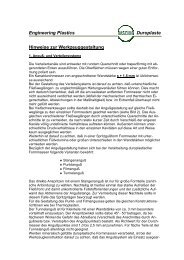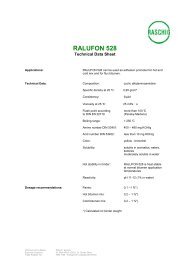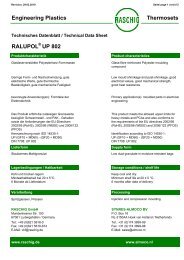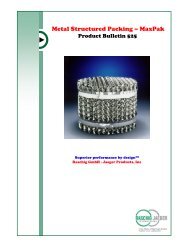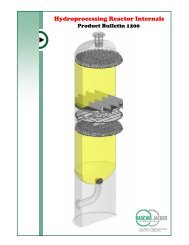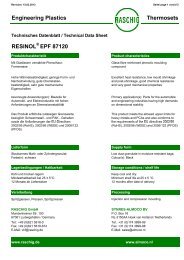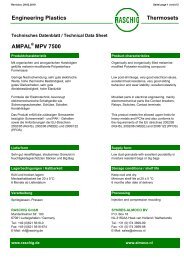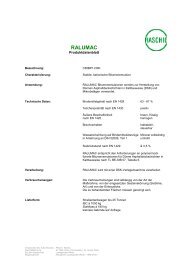Literature - Steam Stripping
Literature - Steam Stripping
Literature - Steam Stripping
You also want an ePaper? Increase the reach of your titles
YUMPU automatically turns print PDFs into web optimized ePapers that Google loves.
<strong>Steam</strong> <strong>Stripping</strong><br />
Stream stripping for water clean-up is essentially a distillation<br />
process where the heavy product is water and the light product is a<br />
mixture of volatile organics. These organics are present in the feed<br />
water, in relatively small concentrations. Since the volatility of the<br />
organics is a very strong function of temperature, the high stripping<br />
temperature inherent in stream stripping allow for the removal of<br />
heavier more soluble organics that are not strippable with air. No<br />
off-gas treatment is needed ad the only wastestream generated is a<br />
small amount of very concentrated organics.<br />
The Jaeger Advantage<br />
Jaeger Products, Inc. has extensive experience in the successful<br />
design of steam stripping systems for organic removal and recovery.<br />
Our engineering staff can provide you with a complete process<br />
design, and with the necessary engineering, specify the contacting<br />
column in detail. We have c complete line of packings, trays, and<br />
tower internals that can satisfy any steam stripping need.<br />
Typical <strong>Steam</strong> <strong>Stripping</strong> Applications<br />
Benzene removal from wastewaters<br />
Sour water (h2O and NH3) stripping<br />
Acetone removal/recovery from wastewaters<br />
Oxygenate (MTBE. MEK) removal/recovery<br />
Removal of chloroform, bromoform and<br />
other halogenated organics from water<br />
Removal of organics from quench waters<br />
Organics recovery from leachates<br />
Alcohol (ethanol, propanol, IPA, butanol)<br />
removal from water<br />
Solvents recovery or removal<br />
(tetrahydrofuran, hexane, heptane)<br />
Superior performance by design<br />
JAEGER PRODUCTS, iNC.<br />
1611 Peachleaf, Houston, Texas 77039<br />
Phone:(281) 449-9500 Fax: (281) 449-9400<br />
(800) 678-0345<br />
http://www.jaeger.com
Removal of Organics From Water Using <strong>Steam</strong> <strong>Stripping</strong><br />
Jaeger Products, Inc<br />
Houston, Texas<br />
Dilute mixtures of organic materials in water can be concentrated by a process known as steam stripping.<br />
The end products of such operation are a clean water stream almost devoid of organic materials, and a<br />
highly concentrated organic stream suitable for recycle to a process or for disposal. The use of heat in the<br />
form of steam as a separating agent offers significant advantages over other methods, such as inert gas (air)<br />
stripping.<br />
WHY USE STEAM STRIPPING?<br />
<strong>Steam</strong> stripping for water clean-up is essentially a distillation process where the heavy product is water and<br />
the light product is a mixture of volatile organics. These organics are present in the feed water in relatively<br />
small concentrations. The process of steam stripping takes place at high temperatures compared to air<br />
stripping, usually very close to the boiling point of water. Since the volatility of the organics is a very strong<br />
function of temperature, the high stripping temperatures inherent in steam stripping allow for the removal<br />
of heavier, more soluble organics that are not strippable with air.<br />
Another very important feature of steam stripping is the fact that no off-gas treatment is needed, and that<br />
the only waste stream generated is a small amount of very concentrated organics. These are easily dealt<br />
with by incineration, biological treatment, or recycled to process.<br />
In summary, steam stripping is a good solution for wastewater streams that contain fairly soluble,<br />
non-volatile organics and where no off-gas stream is desired. On the other hand, steam striping does<br />
necessitate the presence of steam (or process heat) and would tend to be more capital intensive than air<br />
stripping. Ideal settings for steam stripping are oil refineries, petrochemical, and chemical plants.<br />
WHAT IS STEAM STRIPPING?<br />
A wastewater stream is heated and put in intimate contact with steam in a packed or trayed tower. The<br />
combined effects of the steam and heat, or temperature cause organic material to transfer from the liquid<br />
to the vapor phase. This material is then carried out with the vapor. As contacting proceeds down the<br />
tower, the wastewater becomes leaner in the organic material while the vapor phase becomes more<br />
enriched as it travels up the tower.<br />
<strong>Steam</strong> is injected at the bottom of the tower to provide heat and vapor flow. Clean water leaves the bottom<br />
of the tower. The wastewater is fed at the top of the tower and the steam leaves the top heavily laden with<br />
organic material. This steam/organic combination is condensed and processed further as detailed in the<br />
next few pages. The net effect achieved in the steam stripper and condenser is that a contaminated<br />
wastewater and steam are injected into the tower and a clean water stream is obtained. A low-volume,<br />
JPI\1996STMT.DOC
ut concentrated water/organic mixture, is also obtained as a by-product.<br />
WHAT DOES A TYPICAL STEAM STRIPPING UNIT LOOK LIKE?<br />
The configuration of a steam stripping unit can vary depending on the characteristics of the organic material<br />
to be removed, and on what is to be done with it in terms of disposal and recycle. As a minimum, a steam<br />
stripping unit will look like the unit depicted in Figure 1. It is important to note that heat recovery from the<br />
bottom product is necessary for economical operation. Operations at reduced pressure do not need<br />
recovery exchangers, but operate at lower temperatures and larger steam rates. The towers also tend to<br />
be a bit larger in vacuum operations.<br />
<strong>Steam</strong> requirements for stripping vary with the operating pressure, the type of organic, and the degree of<br />
organic removal/recovery. Further, steam requirements for heat balance purposes need to be accounted<br />
for. A very important consideration in the design of a steam stripper is the fact that the column needs to<br />
be capable of handling enough steam flow to operate without the benefit of the recovery exchanger. This<br />
feature will be needed during start-up and when the exchanger is out of service for cleaning.<br />
Some organic materials are not totally miscible in water and separate into a distinct organic phase when<br />
the concentration exceeds the solubility limit. Most aromatics and halogenated organics fall in this<br />
category. <strong>Steam</strong> stripping applications for these types of compounds can be very effective, since a good<br />
part of the concentration of the organic can be accomplished in a decanter as indicated in Figure 2. In this<br />
case, the water layer is recycled to the stripping column for reprocessing. The design of the decanter poses<br />
some interesting questions since the water flow is generally significantly larger than the organic flow.<br />
Furthermore, in some cases (benzene, toluene, etc), the organic layer is the lighter of the two liquid phases.<br />
In applications involving halogenated organics, the organic liquid is heavier than water. Needless to say,<br />
good models to predict the phase behavior of the system in question are essential.<br />
Figures 3A and 3B are refined versions of the flowsheet in Figure 2. These arrangements are needed when<br />
better organic recoveries are needed from more dilute streams. The selection between Figure 3A and 3B<br />
depends solely on the equipment sizing. Figure 3A is used when required steam flows are larger (less<br />
volatile compounds).<br />
Figure 4 is applicable when the organic material to be removed exhibits very high solubility in water. In this<br />
case, a refluxed distillation column is needed to achieve high organic concentrations.<br />
Other variations on the same flowsheets shown above include the use of reboilers instead of direct steam<br />
injection and operation at reduced pressure to reduce operating temperature.<br />
JPI\1996STMT.DOC
CHEMISTRY, CHEMISTRY, CHEMISTRY!!<br />
It is of crucial importance that the designers and operators of steam strippers understand the chemistry of<br />
the system, since lack of operability and maintenance problems occur frequently because of faulty<br />
chemistry.<br />
This is of particular importance in systems that include a multitude of pollutants, since interaction among<br />
them can be large. An excellent example is the typical mixed wastewater from a chemicals manufacturing<br />
facility that includes inorganic acids, organic pollutants, and dissolved gases. As the gases, such as CO2<br />
and or NH3, are stripped, the pH of the water changes causing potential solids precipitation. This is<br />
aggravated by the fact that steam stripping temperatures often exceed the precipitation temperature for<br />
salts, such as calcium carbonate.<br />
The volatility of the compounds to be stripped is often affected by the water chemistry present. Accurate<br />
predictions of the volatility are of extreme importance for proper stripper design; the operators of stripping<br />
systems should always be aware that changes in the chemistry of the incoming water can affect the<br />
removal efficiencies observed in the stripper.<br />
Jaeger Products, Inc. has more experience than any other mass transfer supplier in tackling tough stripping<br />
problems from the chemistry to the equipment.<br />
SOME PITFALLS IN STEAM STRIPPING SYSTEM DESIGN.<br />
Several aspects of the design of steam stripping systems are very crucial and not immediately obvious.<br />
First is the accuracy and reliability of equilibrium data. <strong>Steam</strong> stripping is a situation where the old reliable<br />
Henry's law just isn't applicable due to the broad concentration ranges, high temperatures, extensive<br />
interactions between components, and the existence of two liquid phases. The thermodynamic model of<br />
choice for steam stripping systems is one based on activity coefficients that can predict immiscibility. No<br />
model fits this function better than the NRTL activity coefficient model (non-random two liquid model<br />
developed by Prausnitz and co-workers). Pilot and laboratory tests to establish the adjustable parameters<br />
in the NRTL model for the mixture in question are advisable, but solubility and vapor pressure data can<br />
suffice as a good approximation.<br />
Wastewaters can be very fouling, especially when the temperature is raised and inorganic salts precipitate.<br />
In typical steam stripping configurations, most of the fouling will occur in the recovery exchanger and<br />
design provisions are needed to allow for frequent cleaning. In the absence of a recovery exchanger, the<br />
brunt of the fouling will be taken by the stripper itself. In such cases, the use of trays can be a way to avoid<br />
plugging even though packings would yield better performance characteristics. The use of sequestering<br />
agents is also a good solution for reliable and lengthy operation.<br />
Materials of construction need be some grade of stainless steel or a high performance plastic due to the<br />
varied and changing nature of the water chemistry. Capital savings by use of lesser materials of<br />
construction generally translate into severe problems and added expense later.<br />
Start-up of any steam stripper requires heating of the feed water to the operating temperature in the<br />
stripper. This added heat has to be supplied in the form of steam at the bottom of the stripper. Design<br />
provisions need to be made to accommodate this larger, but temporary, steam flow in the stripper. This<br />
capability is also desirable to allow for continued operation while cleaning of a fouled recovery exchanger<br />
takes place.<br />
JPI\1996STMT.DOC
Design at low stripping steam rates is desirable since it reduces the downstream processing requirements.<br />
Figure 5 illustrates how sensitive the process is to steam flow. Optimum designs require stripping factors<br />
between 1.5 and 4. These stripping factors mandate more stages for separation and taller packed heights.<br />
Design under these conditions becomes very sensitive to the reliability of the equilibrium data and the mass<br />
transfer models. This is also the case where excellent packings and internals are necessary and where<br />
vendor experience in design of steam stripping systems is invaluable.<br />
THE STEAM STRIPPER AND OTHER COLUMNS IN THE SYSTEM.<br />
The contacting devices in the steam stripping system are where the mass transfer takes place. They are<br />
vertical countercurrent vessels filled with a mass transfer device. In general, these devices are either sieve<br />
trays, random packings, or structured packings (the level of efficiency and capacity follows the same order<br />
and so does their sensitivity to fouling).<br />
The columns are also equipped with liquid distributors and support plates for the packing. In the case of<br />
deep bed requirements, intermediate liquid collectors and redistributors are also installed to ensure good<br />
performance. Figure 6 shows different combinations of internals that can be installed in a steam stripper.<br />
In most cases though, only combinations of trays and packings (with the associated internals) are used.<br />
Jaeger Products, Inc. offers all internal devices necessary for steam strippers and distillation columns in<br />
a variety of designs and materials to suit the application.<br />
HOW CAN JAEGER HELP YOU IN STEAM STRIPPING APPLICATIONS?<br />
Jaeger Products, Inc. has extensive experience in the successful design of steam stripping systems for<br />
organic removal and recovery. Our engineering staff can provide you with a complete process design, and<br />
with the necessary engineering, specify the contacting column in detail, and supply you with all process<br />
specification for the peripheral equipment as illustrated in Figure 7. Our database is very extensive and<br />
chances are there are very few organics we have not tackled. We can simulate and optimize a complete<br />
steam stripping and solvent recovery unit using the most advanced and comprehensive models. Our<br />
calculations will account for unusual vapor/liquid equilibria and will incorporate the best mass transfer<br />
efficiency rating methods available.<br />
We have a complete line of packings, trays, and tower internals that can satisfy any steam stripping needs.<br />
The performance of the system depends heavily on the correct internals selection as well as on a good<br />
process design; Jaeger can assist you with both so that total responsibility is easily identified. Although<br />
we normally do not provide turn-key systems, we can direct and/or assist you in such a project. We can<br />
also put you in contact with a systems manufacturer that would provide a turn-key project with Jaeger<br />
engineering and hardware.<br />
JPI\1996STMT.DOC
THE JAEGER ADVANTAGE<br />
Typical <strong>Steam</strong> <strong>Stripping</strong> Applications<br />
Benzene removal from waste waters<br />
Sour water (H 2S and NH 3) stripping<br />
Phenol recovery<br />
Acetone removal/recovery from waste waters<br />
Oxygenate (MTBE, MEK) removal/recovery<br />
Removal of chloroform, bromoform and other halogenated organics from water<br />
Removal of various organics from quench waters<br />
Concentration and organics recovery from leachates<br />
Alcohol (ethanol, propanol, IPA, butanol) removal from water<br />
Solvent recovery or removal (tetrahydrofuran, hexane, heptane)<br />
<strong>Steam</strong> stripping facts<br />
Capable of achieving very high removals and low effluent concentrations<br />
Most economical removal technique at feed concentrations above 0.1% weight organics<br />
Cost effective at feed concentrations as low as 200 ppm<br />
Can produce a re-usable concentrated product<br />
Minimizes air emissions<br />
Reduces loads to incineration<br />
Can be operated at vacuum or pressure depending on needs with little penalty<br />
Can be made very energy efficient with heat recovery<br />
Fouling is a continuous concern<br />
Typical hardware for steam strippers<br />
Sieve trays for fouling service (SS, Monel)<br />
Metal random packings for most applications (SS, Monel)<br />
Plastic random packings for acid service (GFPP, Noryl, PVDF, Teflon)<br />
Metal structured packings for high efficiency/capacity (SS, Monel, Aluminum)<br />
Column internals to include: distributors, redistributors, supports, and mist eliminators<br />
JPI\1996STMT.DOC
STEAM STRIPPING<br />
Application information for design<br />
(Copy, fill out, and fax pertinent information and we will be glad to assist you with a design.)<br />
Company<br />
Person Responsible<br />
Address<br />
Telephone Fax<br />
Your Reference Date<br />
Description of problem, diagram:<br />
JPI\1996STMT.DOC
Utilities Available:<br />
Heating medium: Saturated steam Heat transfer oil Hot water<br />
for steam: pressure psi, temperature °F<br />
Coolant: Water Brine<br />
Temperature Inlet--summer °F, winter °F<br />
Mass balance for continuous rectifying column<br />
Streams Feed F = lb/h<br />
Distillate D = lb/h<br />
Bottom product B = lb/h<br />
<strong>Steam</strong> S = lb/h<br />
Composition of streams or desired purities<br />
Outlet--maximum °F, minimum °F<br />
Please place a check against the units in which the specification is made:<br />
lb/h Weight % Mole fraction PPM PPB<br />
Table 1A<br />
Component (I)<br />
Name<br />
Mole Mass<br />
Feed F<br />
Distillate D<br />
Bottom<br />
1 2 3 4 5 Total<br />
JPI\1996STMT.DOC
Data for separation problem<br />
Column operated: continuously intermittently<br />
Maximum bottom temperature tolerated °F, bottom pressure psia<br />
or head pressure psia, and maximum pressure drop tolerated psi<br />
Calculated pressure performance data (if separation problem has been calculated by the customer)<br />
Number of theoretical stages in rectifying section (section D) =<br />
in stripping section<br />
Total<br />
(section B) =<br />
Loading Nominal load = 100% (Load range) - %<br />
Column head: Gas G D = lb/h M = lb/lbmol p D = psia<br />
Liquid L D = lb/h ρ L = lb/lbmol t D = °F<br />
Bottom: Gas G B = lb/h M = lb/lbmol p B = psia<br />
Liquid L B = lb/h ρ L = lb/lbmol t B = °F<br />
Feed liquid at boiling point vapor partly vapor flash %<br />
Is there danger of precipitation? yes/no<br />
foaming? yes/no<br />
Column sizing by Jaeger by customer<br />
Column internal diameter in.<br />
Packing type total h eight ft.<br />
Number of sections , rectifying section , stripping section<br />
JPI\1996STMT.DOC
Table 2<br />
PHYSICAL DATA OF THE PURE COMPONENTS<br />
Designation of components Units 1 2 3 4 5<br />
Name of components -<br />
Molecular Weight lb/lbmol<br />
Density °F (liquid) lb/ft<br />
Dynamic viscosity<br />
G: vapor _____ °F<br />
L: liquid _____ °F<br />
Heat of evaporation Btu/lb<br />
Boiling point<br />
(Vapor pressure curves)<br />
of the pure components)<br />
or<br />
Antoine constants<br />
log p = A - B/(C+t)<br />
or<br />
Henrys constants (H)<br />
cp<br />
p or H<br />
in<br />
atmosphere<br />
G L G L G L G L G L<br />
p/H t(°F)<br />
A= A= A= A= A=<br />
B= B= B= B= B=<br />
C= C= C= C= C=<br />
JPI\1996STMT.DOC



